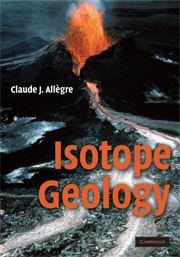Book contents
- Frontmatter
- Contents
- Preface
- Acknowledgments
- Isotopes and radioactivity
- The principles of radioactive dating
- Radiometric dating methods
- Cosmogenic isotopes
- Uncertainties and results of radiometric dating
- Radiogenic isotope geochemistry
- Stable isotope geochemistry
- Isotope geology and dynamic systems analysis
- References
- Appendix
- Further reading
- Solutions to problems
- Index of Names
- Subject Index
Isotope geology and dynamic systems analysis
Published online by Cambridge University Press: 05 June 2012
- Frontmatter
- Contents
- Preface
- Acknowledgments
- Isotopes and radioactivity
- The principles of radioactive dating
- Radiometric dating methods
- Cosmogenic isotopes
- Uncertainties and results of radiometric dating
- Radiogenic isotope geochemistry
- Stable isotope geochemistry
- Isotope geology and dynamic systems analysis
- References
- Appendix
- Further reading
- Solutions to problems
- Index of Names
- Subject Index
Summary
We have seen that the Earth can be subdivided into five main reservoirs:
(1) the continental crust, where elements extracted from the mantle are stored (K, Rb, U, Th, rare earths, etc.) and which is made up of age provinces assembled like a mosaic;
(2) the upper mantle, the MORB source, which is mainly a residue of extraction of continental crust and the place where oceanic crust is formed and destroyed;
(3) the lower mantle, of which little is known by direct information other than that it is the source of the rare gas isotope signature in OIB;
(4) the atmosphere, which is the recipient of rare gases given out by the mantle and is not sealed for some gases (He, Ne); and
(5) the hydrosphere, which is the driving force and the potential vector of all transfers of material at the surface, through the cycle of erosion, transfer, and sedimentation.
These reservoirs exchange material with each other. Material is extracted from the upper mantle to form the continental crust, probably during subduction processes. Material from the landmasses is reinjected into the upper mantle, either during subduction or during episodes when the continental crust is delaminated and falls into the mantle (Dupal province).
Exchanges probably occur between the lower and upper mantle, as shown by mass balance calculations for the depleted mantle and the results for rare gases, implying the existence of two reservoirs in the mantle, with injection of the lower mantle into the upper mantle.
- Type
- Chapter
- Information
- Isotope Geology , pp. 436 - 472Publisher: Cambridge University PressPrint publication year: 2008



